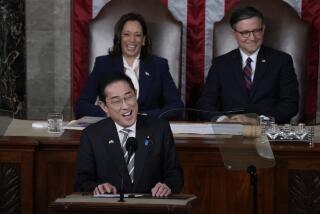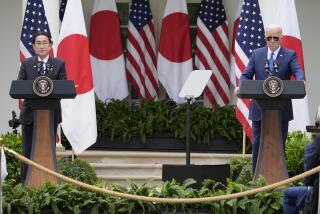Cheney Urges Japan to Raise Share for Defense : Military: He tells Tokyo that U.S. forces in the Pacific will shrink, and Asian allies must bear more of the cost.
- Share via
TOKYO — Defense Secretary Dick Cheney told Japanese officials Thursday that the United States intends to withdraw over the next three years 5,000 to 6,000 of the 57,000 troops it now has stationed in Japan, but offered reassurance that Japan remains the “linchpin” of U.S. Pacific strategy.
In exchange for the American military umbrella over the region, Cheney asked Tokyo to assume a significantly greater share of the $7-billion annual cost of maintaining U.S. forces here and to relax restrictions on transfer of Japanese technology to the United States.
Cheney’s four-day visit to Japan concludes a two-week swing through East Asia in which he presented a marked shift in the U.S. defense posture in the Pacific. Because of a sharply reduced Soviet threat and a Congress determined to slash the Pentagon’s budget, Cheney said U.S. forces in the Pacific will shrink while Washington will demand that its Asian allies assume a far greater share of the region’s defense burden.
The defense secretary noted that South Korea and Japan have become economic powerhouses capable of spending more on their own defenses, while the United States is undertaking a fundamental reassessment of its costly global military role. All the while, he sought to reassure the Asian allies that the United States is not abandoning them.
Cheney’s message comes at a time of widening strains in the U.S.-Japan relationship, particularly over trade. But officials of both governments described the Cheney talks with senior Japanese leaders as cordial.
In a speech today in Tokyo, Cheney outlined the continuing military threats in Asia, from the still-formidable Soviet navy to internal instability in many Asian nations to proliferation of ballistic missiles and nuclear weapons technology.
“Given these potential dangers to regional security, it should be clear that the United States could not ever think of a withdrawal from Asia,” the Pentagon chief said. “However, it is true, as you have probably heard, that we are thinking about making some force adjustments.”
In response to a question after the speech, Cheney disclosed publicly for the first time that the Pentagon plans to withdraw over the next three years about 10% of the 120,000 U.S. troops now based in East Asia.
Cheney’s message unsettled the South Koreans, who fear that a precipitous U.S. retreat will embolden the hostile communist North Koreans to attack. The Filipinos reacted with anger, because Cheney indicated that the United States would be unable to meet earlier pledges of military and economic aid.
The Japanese, however, accepted the cuts with more equanimity and expressed an appreciation for the bind Cheney is in, according to officials who attended the meetings between the defense secretary and senior Japanese leaders.
Foreign Minister Taro Nakayama cautioned Cheney, however, that adjustments in U.S. forces must be based on objective conditions in Asia--which he called “unclear and complex”--and should be subject to periodic review, a Foreign Ministry official said. Prime Minister Toshiki Kaifu joined Nakayama in expressing to Cheney the belief that forward-deployed U.S. forces in the Pacific are “essential and indispensable” to regional security, but both said they are aware of competing demands on the U.S. budget.
A senior Pentagon official traveling with Cheney concurred. “They understand the American political system. They understand the strategic environment is changing. They think it is a positive development that we’re looking out over several years rather than letting Congress dictate” military policy, the official said.
The Japanese, without providing specific promises, said they would increase their contribution to the cost of maintaining U.S. soldiers, sailors and air force personnel here.
Japan currently pays $2.4 billion of the $7-billion annual cost of supporting U.S. troops on the islands, but has budgeted 468 billion yen ($3.2 billion) for fiscal 1990, which begins April 1.
Washington would like Tokyo to increase that share to 60%, or more than $4 billion a year, by picking up the tab for utilities, telecommunications and local labor at U.S. installations.
Japanese leaders privately said they would provide some, if not all, of the requested increase. “The Japanese are very understanding and very much willing to help as much as they can,” one U.S. official who participated in the meetings said.
As a gesture of reassurance to the Japanese, Cheney announced that the U.S. Navy would transfer the aircraft carrier Independence to Japan when the World War II-era carrier Midway, now stationed at Yokosuka, Japan, is retired next year.
Both carriers are conventionally powered, as opposed to nuclear, a subject of great sensitivity here for obvious historical reasons. The Japanese are the only people to have suffered the devastation of atomic bombs.
The Japanese had feared that the Midway would be pulled out and not replaced. Both Kaifu and Nakayama thanked Cheney for deciding to transfer the Independence, commissioned in 1959. The move, however, represents a loss for San Diego, the ship’s home port.
In two hours of meetings Thursday, Cheney told his counterpart, Juro Matsumoto, director of the Japan Defense Agency, that the troop cuts “will be done without affecting our combat capabilities,” Pentagon spokesman Pete Williams said. “We will continue to modernize and upgrade our forces in the region,” he quoted Cheney as telling Matsumoto.
Cheney also met with former Prime Minister Noboru Takeshita and former Foreign Minister Shintaro Abe, a ruling party strongman widely expected to be Japan’s next prime minister.
More to Read
Get the L.A. Times Politics newsletter
Deeply reported insights into legislation, politics and policy from Sacramento, Washington and beyond. In your inbox twice per week.
You may occasionally receive promotional content from the Los Angeles Times.










